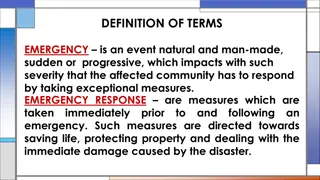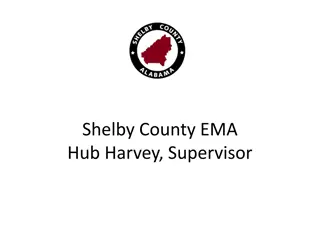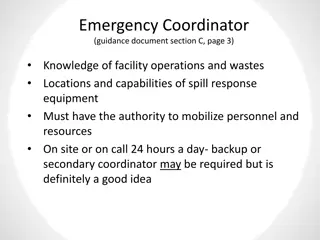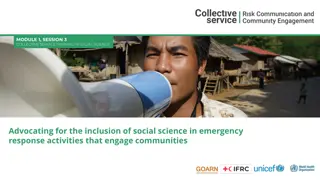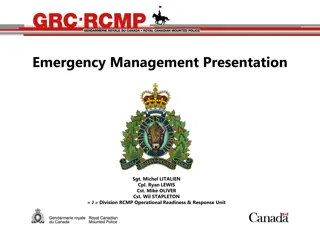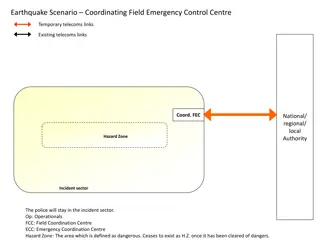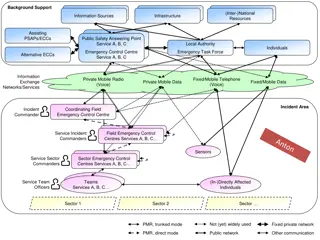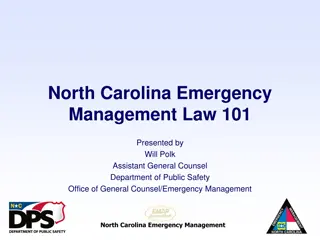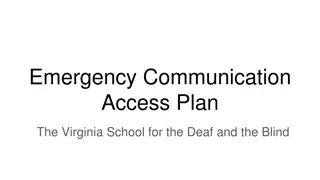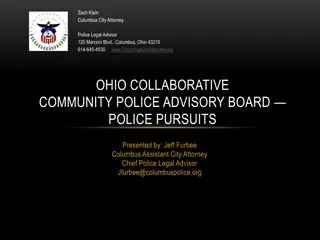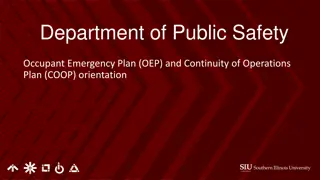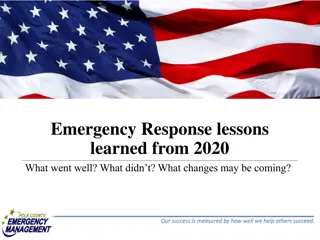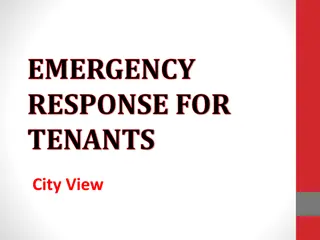Creating Enabling Environments for Social Science in Emergency Response
Explore the importance of creating an enabling environment to utilize social science findings effectively in emergency response. Learn key questions in social science research, the cluster approach, and aspects of an enabling environment for impactful community-centered actions.
Download Presentation

Please find below an Image/Link to download the presentation.
The content on the website is provided AS IS for your information and personal use only. It may not be sold, licensed, or shared on other websites without obtaining consent from the author. Download presentation by click this link. If you encounter any issues during the download, it is possible that the publisher has removed the file from their server.
E N D
Presentation Transcript
MODULE 6, SESSION 2 COLLECTIVE SERVICE TRAINING IN SOCIAL SCIENCE Enabling environments for the uptake of social science in emergency response
LEARNING OUTCOMES Be able to identify opportunities to create an enabling environment for uptake of social science findings within response pillars, technical clusters and sectors Be able to identify opportunities to embed operational social science across different phases of a community- centred response Understand what an enabling environment looks like at the community level to ensure that research can inform local action
KEY QUESTIONS IN SOCIAL SCIENCE RESEARCH 1. What information is needed? 2. Who needs this information? 3. Does this information already exist? Is there a related needs assessment or study? DATA TO ACTION: 4. Who can collect this information? 5. What methodology and tools should be used to collect and analyse this information? Key questions in social science research 6. How to ensure that this information goes back to communities? To inform community-level actions and decision-making of the broader response? 7. How to ensure that the information is used to make operational and/or strategic decisions? 8. How to track the information used to ensure that it effectively contributes to operational and strategic priorities?
AN ENABLING ENVIRONMENT: THE CLUSTER APPROACH Clusters are groups of humanitarian organizations (UN and non-UN) working in the same sector: protection, education, WASH, etc. There are global and country-level clusters. Global clusters are always active. Country-level cluster activities include: Supporting service delivery by coordinating the Humanitarian Response Plan Informing strategic decision-making, including preparing needs assessments and analysis of gaps and undertaking information management Planning and implementing cluster strategies and plans, including funding requirements and proposals Monitoring and evaluating progress Building national capacity in preparedness and contingency planning Carrying out necessary advocacy activities
ASPECTS OF AN ENABLING ENVIRONMENT What might need to exist within the emergency response environment to make sure that the findings of social science research are actually used?
ASPECTS OF AN ENABLING ENVIRONMENT Collaboration readiness speaking the same language Flexibility and adaptability in response action Structural factors where social science sits Existing knowledge and capacity Relationships and trust Economic factors
INDIVIDUAL EXERCISE Write some notes about what you see as the pros and cons of the different options for where social science can sit: 1. Embedded in community engagement/communication sector 2. Cross-cutting across operations 3. Stand-alone, independent social science pillar
COLLABORATION READINESS Have you had experience where people from a social science background had challenges communicating with those from a different discipline? What happened and what were the consequences? Giving examples specific to your field of expertise (or to a specific emergency response), how would you explain the value of social science evidence?
CASE EXAMPLE Working in an enabling environment CASE EXAMPLE Longer-term engagement relationship and reputation building in Sierra Leone
GROUP EXERCISE What aspects of an enabling environment are critical to promote at different stages of an emergency response? In your group discuss each point described in relation to: 1. Preparedness 2. Response 3. Recovery Collaboration readiness speaking the same language Flexibility and adaptability in response action Structural factors where social science sits Existing knowledge and capacity Relationships and trust Economic factors
AN ENABLING ENVIRONMENT AT THE COMMUNITY LEVEL What might be some of the aspects of an enabling environment at the community level?
SUMMARY The environment (for this work) are the systems, institutions and actors that make up the emergency response that our social science research intends to influence. This includes a host of response pillars, technical clusters and sectors, and the communities affected by the crisis. There is no single formula for creating an enabling environment: much will depend on the setting and the nature of the emergency response. In each context, however, we can pay attention to the following factors: Existing knowledge and capacity Structural factors, including where social science sits in the humanitarian infrastructure Collaboration readiness in terms of speaking the same language Strong relationships and the establishment of trust Flexibility and adaptability in response action Economic factors, including what financial and human resources are available to implement any recommendations made
SUMMARY These factors are of differing importance depending on the phase of the response: preparedness, response or recovery. To ensure that social science evidence supports community-level action, it is important to understand what an enabling environment looks like at the community level Many of the factors are the same, in terms of community involvement in the research engagement of important community structures and decision-makers, strong relationships and trust with key community-level personnel, familiarity with social science within the community, being open to input from social science research, and having adequate community-level resources to implement any recommendations of the research.





